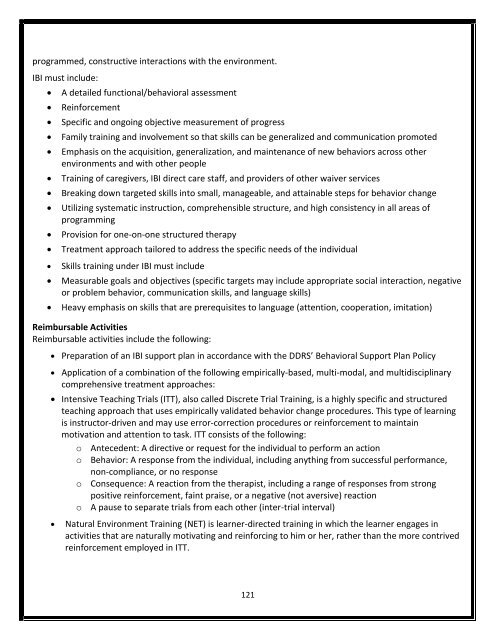DDRS Waiver Manual
2dXf5Pj
2dXf5Pj
You also want an ePaper? Increase the reach of your titles
YUMPU automatically turns print PDFs into web optimized ePapers that Google loves.
programmed, constructive interactions with the environment.<br />
IBI must include:<br />
<br />
<br />
<br />
<br />
<br />
<br />
<br />
<br />
<br />
<br />
<br />
<br />
<br />
A detailed functional/behavioral assessment<br />
Reinforcement<br />
Specific and ongoing objective measurement of progress<br />
Family training and involvement so that skills can be generalized and communication promoted<br />
Emphasis on the acquisition, generalization, and maintenance of new behaviors across other<br />
environments and with other people<br />
Training of caregivers, IBI direct care staff, and providers of other waiver services<br />
Breaking down targeted skills into small, manageable, and attainable steps for behavior change<br />
Utilizing systematic instruction, comprehensible structure, and high consistency in all areas of<br />
programming<br />
Provision for one-on-one structured therapy<br />
Treatment approach tailored to address the specific needs of the individual<br />
Skills training under IBI must include<br />
Measurable goals and objectives (specific targets may include appropriate social interaction, negative<br />
or problem behavior, communication skills, and language skills)<br />
Heavy emphasis on skills that are prerequisites to language (attention, cooperation, imitation)<br />
Reimbursable Activities<br />
Reimbursable activities include the following:<br />
Preparation of an IBI support plan in accordance with the <strong>DDRS</strong>’ Behavioral Support Plan Policy<br />
Application of a combination of the following empirically-based, multi-modal, and multidisciplinary<br />
comprehensive treatment approaches:<br />
Intensive Teaching Trials (ITT), also called Discrete Trial Training, is a highly specific and structured<br />
teaching approach that uses empirically validated behavior change procedures. This type of learning<br />
is instructor-driven and may use error-correction procedures or reinforcement to maintain<br />
motivation and attention to task. ITT consists of the following:<br />
o Antecedent: A directive or request for the individual to perform an action<br />
o Behavior: A response from the individual, including anything from successful performance,<br />
non-compliance, or no response<br />
o Consequence: A reaction from the therapist, including a range of responses from strong<br />
positive reinforcement, faint praise, or a negative (not aversive) reaction<br />
o A pause to separate trials from each other (inter-trial interval)<br />
<br />
Natural Environment Training (NET) is learner-directed training in which the learner engages in<br />
activities that are naturally motivating and reinforcing to him or her, rather than the more contrived<br />
reinforcement employed in ITT.<br />
121


